|
Showing posts with label Big Planet Comics. Show all posts
Showing posts with label Big Planet Comics. Show all posts
Tuesday, January 01, 2019
Big Planet New Year's holiday hours and sale
Sunday, October 28, 2018
Meet a Visiting Comic Book Writer: A Chat with Nejc Juren of Slovenia
 by Mike Rhode
by Mike RhodeEarly next month, DC will have the rare treat of two Slovenian cartoonists visiting to sign their Animal Noir graphic novel and open an exhibit of comic art at the Embassy of Slovenia. Last week, we interviewed Izar Lunaček.Today, we chat with Nejc Juren, the co-author of Animal Noir.
What type of comic work or cartooning do you do?
I write scripts. I'm so bad at drawing that I never dared to hope I could do any work in comics. However, I've always loved comics, and since I consider myself more of a storyteller then a writer, I jumped at the chance when Izar suggested we tell some stories together in comic book form. I truly believe comics are one of the best storytelling mediums. The possibilities here are endless.
How do you do it? Traditional pen and ink, computer or a combination?
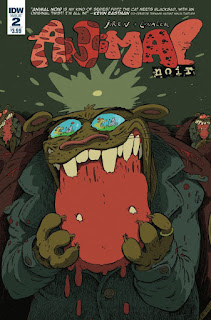 I try to adapt to the process of the illustrator. If he needs a panel by panel script, I try to write it that way, but I prefer the process to be more loose. I tell the illustrator the broad story and then I let his visual ideas guide and shape the script. With Izar, the process was just incredible. When we did Animal Noir we spent a couple of months just world-building. We really went into the foundation of the world those animals created. Then we created the long arc of the story (which has yet to be told and I guarantee is really epic) and only then all the small arcs, the first of which came out last year from IDW.
I try to adapt to the process of the illustrator. If he needs a panel by panel script, I try to write it that way, but I prefer the process to be more loose. I tell the illustrator the broad story and then I let his visual ideas guide and shape the script. With Izar, the process was just incredible. When we did Animal Noir we spent a couple of months just world-building. We really went into the foundation of the world those animals created. Then we created the long arc of the story (which has yet to be told and I guarantee is really epic) and only then all the small arcs, the first of which came out last year from IDW.When (within a decade is fine) and where were you born?
I was born in 1982. Slovenia was a part of Yugoslavia and a socialist country. Yugoslavia dissolved when I was 8 years old and I grew up watching a lot of American television.
Where do you live now?
I live in Ljubljana, our nation's capital.
What is your training and/or education in cartooning?
I always got the worst marks in drawing. But I also always got the worst mark in music and now I make ends meet by writing comic scripts and running a semi-popular swing band. As for formal education, I finished law school.
Who are your influences?
René Goscinny, Allan Moore, Joan Sfar, Christophe Blain.
If you could, what in your career would you do-over or change?
I don't think I'd change anything. I kinda take it like this: it takes around 20 years to become a good storyteller. So that's a really long journey. And the more you meander, the more you get lost and side-tracked, the more walls you hit, all that should - by this theory - just add to your journey. That's why I'm trying to cherish all the wrong turns I take.
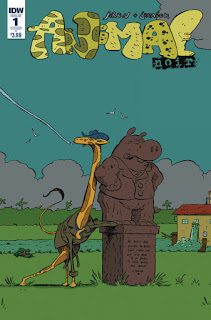
What work are you best-known for?
In comics, it's Animal Noir. However, in Slovenia I'm more known as a musician. This is my band, Počeni Škafi, if you want to check us out. I write all the lyrics and most of the music. In English, it means The Cracking Buckets. Our original singer's surname was Škafar, which means the bucket maker.We have an album on Spotify and all the other streaming sites, but a good sample is here: https://youtu.be/WM5yLKnJwl0
What work are you most proud of?
You'd make me choose among my children? Okay, check this video out. It's the first thing Izar and I did together. Dive is a short comic that was done as a music video for Fed Horses, a band I also write lyrics for. I'm really happy the way it turned out but I don't think the Youtube algorithm likes it too much.
What would you like to do or work on in the future?
Izar and I are working on a comic called Thursday Girl that I think will be great. We're hoping to find a publisher soon so we can get our claws into it. I'm also preparing a collection of short stories that's going to get released next year.

What do you do when you're in a rut or have writer's block?
I stop and let my brain solve it on it's own. I have a constant writer's block and usually resolves it self around deadlines. Or I find that a long walk or a long shower really helps.
What do you think will be the future of your field?
Who knows? But stories will always be important. And if by some chance the world gets overrun by amazing storytellers and will have no use for me, I'll just go back into law.
What conventions do you attend?
I usually go to the Angouleme festival in France. It's super nice.
Have you visited DC before?
Yes. I visited in 98. I was an international student at the Governor's school of South Carolina and we make a field trip.
If so, favorite thing? Least favorite? If not, what do you want to do?
I remember putting my finger into Einstein's nose.
If you've visited, what monument or museum do you like?
I guess the answer is again Einstein. I'm not into the big phallic monuments. I did enjoy the Air & Space Museum.
What can you tell us about your book that you're signing at Big Planet Comics?
One of Goodreads reviewers called it: so intensely overthought that it's hard to tell if it's good or just totally insane. I guess that's my work.
Did Animal Noir when we appear in the United States, or did it appear in your country first? How did you guys bring it to the attention of IDW? Did you do the English script yourselves?
Animal Noir came out in the US first. Some publishing houses in Slovenia liked it, but none wanted to risk the investment. The Slovenian comics market is very small. Our original plan was to find a publisher in France and the first few pages were drawn in a little larger format. When IDW showed interest, we adapted it to the floppy format and we re-wrote the script to fit it into 20-page episodes.
Izar met Ted Adams at the comics festival in Barcelona, pitched him the story and showed him a few pages. Ted liked it so much, he also took on the editing duties. It was surreal for us.
Yeah, we wrote Animal Noir in English. When in came out in Slovenia 6 months later, we needed to translate it into our mother tongue. Moreover, when we did the world-building we named everything in English with some reckless abandon, so we put ourselves in some tight spots when we needed to translate those names into Slovenian.
Do you have a website or blog?
No. But you can follow me on Instagram.
As Izar Lunaček noted on our blog last week:
The first days of November will see a double hit of Slovenian comics descend on Washington DC. On Thursday November 1st at 7PM, Nejc Juren and Izar Lunaček will swing by Big Planet Comics on U St., NW to talk about and sign their book Animal Noir, a comic thriller about a giraffe detective in a world of lion politicians and hippo mobsters that came out with IDW last year, and on the 2nd the same guys will open an exhibition on the vivid history of their own country's comics scene at the Slovenian embassy on California Street. Admission to both events is free and food and drinks might be served. Come on, come all, it'll be wonderfully fun!

Sunday, October 21, 2018
Meet a Visiting Cartoonist: A Chat with Izar Lunaček of Slovenia
 by Mike Rhode
by Mike Rhode Early next month, DC will have the rare treat of two Slovenian cartoonists visiting to sign their graphic novel and open an exhibit of comic art at the Embassy of Slovenia (which was part of Yugoslavia when I was young). As Izar Lunaček noted on our blog last week:
The first days of November will see a double hit of Slovenian comics descend on Washington DC. On Thursday November 1st at 7PM, Nejc Juren and Izar Lunaček will swing by Big Planet Comics on U St., NW to talk about and sign their book Animal Noir, a comic thriller about a giraffe detective in a world of lion politicians and hippo mobsters that came out with IDW last year, and on the 2nd the same guys will open an exhibition on the vivid history of their own country's comics scene at the Slovenian embassy on California Street. Admission to both events is free and food and drinks might be served. Come on, come all, it'll be wonderfully fun!
He was also willing to answer a slight modification of our usual questions.
What type of comic work or cartooning do you do?
Funny and thoughtful are probably my two mainstays. I love comedy and I'm a trained philosopher, so that's probably the stem of that. Within those margins, however, I've done everything from anthropomorphic newspaper strips to socially critical detective novels to autobio and science stuff.
How do you do it? Traditional pen and ink, computer or a combination?
I love drawing by hand, still, the scratches of the crowquill pen and the smooth waves of the brush intoxicate me. That said, I have started coloring mostly on the computer because it simply reproduces so much better. Plus, I like the stark look of computer graphics used sparingly.
When (within a decade is fine) and where were you born?
At the very end of the seventies in Yugoslavia. I grew up reading great local and Italian comics (Marvel was a bit off-limits because ... Communism) that you can learn more about at the expo opening. When I was 12, however, my birthplace broke up into a buch of smaller states, accompanied by a bloody war. Lucky for us, Slovenia only got off with a 10-day skirmish and a couple dozen dead. It has, however, lost the entire huge, cosmopolitan Yugoslav comic market and that's something we're all still recovering from.
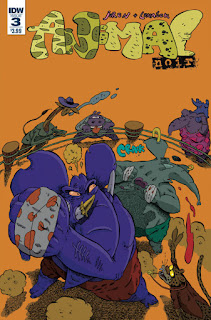
Where do you live now?
In Ljubljana, Slovenia's tiny capital. It's a beautiful little town with just over a quarter million folks, but all the perks of a capital, from well stocked bookshops to possible investors to great party venues. It has a river winding through downtown where you can sit and drink and sketch and chat, I love living there. The only downside is the minuscule market that can't really support comic creators - not even commercially-bent ones - hence my regular job-seeking trips to France and the US.
What is your training and/or education in cartooning?
I studied classical painting. Mainly because all of my favorite Slovenian cartoonists (TBC, Miki Muster, Magna Purga - you'll learn about them at the exhibit 😊) attended the same Ljubljana academy of fine arts. It's not really an "Art School;" it's more of the army crossed with apprenticeship; you had to be there the whole day, no excuses, from morning til night, and somebody was constantly shouting at you while the whole class stood still and didn't dare object too much. It's very classical, with obligatory attendance to daily session of drawing naked old bums posing for cheap and learning how to mix your own paint and stretch canvases and listening to lectures on art history. But it was great; together with my PhD in philosophy, it's given me a wonderful grab-bag of crafts and ideas to do comics with.
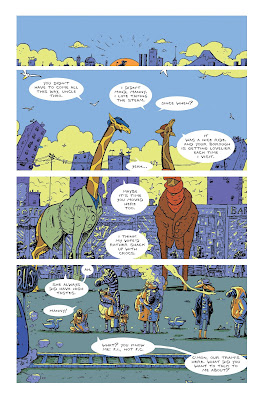
Who are your influences?
Apart from the local guys mentioned above, I read a lot of newspaper comics as a kid - Calvin and Hobbes, Pogo, Krazy Kat - and later moved on to more mature stuff by Alan Moore, but also Moebius and the madmen gathered around the Parisian mag Charlie Hebdo. I'm currently freshly charmed by French new wave comics with guys like Joann Sfar and Christophe Blain, but have also been discovering American gems I'd overlooked before - like Mignola. I guess an unlikely combo of whimsically loose and fatefully blocky art is what drives me at the moment.
If you could, what in your career would you do-over or change?
Maybe I'd have gone to New York for a few years in my twenties which I always dreamed of, but was stopped by a bad relationship at home. It'd be fun to have gotten some isolated, unanchored, bridge-burned work done at that time. Other than that, everything's been pretty great.
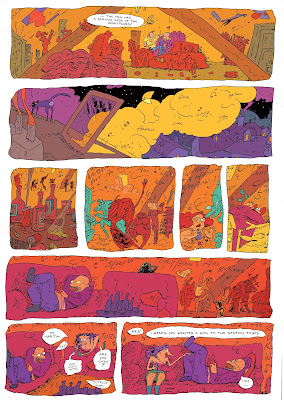
What work are you best-known for?
In Slovenia a whole generation grew up on my newspaper comics in the early 2000s and I still get patted on the back for that at parties. Internationally, I made a tiny splash with an intricate webcomic called Paradise Misplaced that was later published in book form both in Spain and the UK. And in the States, my one claim to fame is IDW's recent Animal Noir series I co-wrote with Nejc Juren, a fantastic Slovenian writer and good friend. We're trying to get more stuff published over here, but meanwhile, we always have our home public as a grateful if not always paying recipient.
How does one pronounce "Nejc?"
Nejc is pronounced Neyts (j is like y and c is like ts in Slovenian). It's short for Jernej so Jerry basically.
What was your comic strip about?
The newspaper comic was about two tiny animals, the inquisitive, species-unidentified Professor and his unwitting helper Hedge the hedgehog. They'd live at the edge of a human city, discover human artifacts and devise ingenious theories about them. Or put on a theater show for the other animals or talk about politics etc, etc: in short, philosophical mayhem infused with a whole lot of silliness.
What work are you most proud of?
I currently just love working on my biweekly blog for a Slovenian web-paper. I think I've broken new ground there like I haven't felt in a long time. And the five people who actually read comics in Slovenia all love it.
 What would you like to do or work on in the future?
What would you like to do or work on in the future?I'd love to do some more ambitious stuff for France or the States, just to kick me into gear for a bit and get me to test my boundaries. Working on Animal Noir for IDW was really rewarding, so another project of that scope would be wonderful. My co-writer and I on that are currently working on a slice of life romantic dramedy set among the Ljubljana student population; that's fun and might get greenlit by a British publisher soon. While waiting, however, I just spew out pitches on everything from Greek monsters to killer Santas and cities populated entirely by birds and I'll jump into any one of them with gusto the moment I get a bite.
What do you do when you're in a rut or have writer's block?
I walk around town, I chat to people and I sketch and doodle and play. Chasing the zing but not so hard to chase it away. But that's when I'm between projects. If I have a deadline, I usually just plow through it, goggles on, engine revving, and it usually works, more or less.
What do you think will be the future of your field?
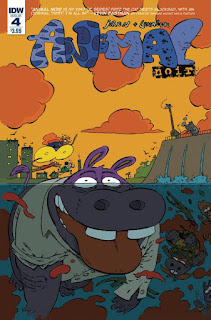 My hope is for comics to get increasingly accepted by the general populace. I love the French way where everybody reads comics resulting in a wide range of genres from art to trash to non-fiction to mellow pop. That's my hope but I think it stands a chance too; telling stories in graphic, easily graspable form is very much a trend now and I'd be willing to bet it's a long-term one.
My hope is for comics to get increasingly accepted by the general populace. I love the French way where everybody reads comics resulting in a wide range of genres from art to trash to non-fiction to mellow pop. That's my hope but I think it stands a chance too; telling stories in graphic, easily graspable form is very much a trend now and I'd be willing to bet it's a long-term one.What conventions do you attend?
I go to either Angouleme or St Malo, the two biggest French comic festivals, every year. Those are great for just seeing all these personal, passionate stories enabling their authors to survive on the sales. I went to San Diego Comic-Con for the first time last year to sign Animal Noir and it was a soul-sucking experience to see an entire art form get trampled by its own geeky spinoffs. This year, I'm planning to stay in the US long enough to attend the Comics Art Brooklyn festival and I'm guessing I'll leave with a much better aftertaste.
Have you visited DC before?
Once, a few years ago. It's where a girl lives who I've been pen-pals with since we were 13. I visited her and played with her kids and baked burgers with her hubby on the back lawn. I hope they'll have us over this year too.
 If you've visited, what monument or museum do you like?
If you've visited, what monument or museum do you like?I visited some strange sights during my first visit. I asked my hosts to take me to Baltimore and to the Chesapeake River and Cooke's Point in Maryland, because I'd been translating John Barth's The Sot-Weed Factor novel into Slovenian and really wanted to visit the intricately described geography of the book I'd been living in for a year.
Can you tell us about your book talk at Big Planet Comics on U St?
On November 1st at 7PM me and Nejc will be signing Animal Noir, a hardboiled thriller starring a giraffe detective loose in a city of lion politicians and hippo mobsters. We'll be talking about making the series too, writing the stories and creating the complex world enabling a range of African animals to live in relative harmony. The book came out last year with IDW and the company's legendary founder, Ted Adams, to whom I'd pitched the idea at a Barcelona comic festival, served as the series' dedicated editor for its brief four issue run. The book wasn't a huge hit, though, so it wasn't renewed for a second series, but we're shopping around for someone to get it running again 'cause we just love it. It got some really nice reviews too so I guess we're not the only ones.
Who does what on Animal Noir and how do you divide up the work?
The basic idea (giraffe detective in a world of mafia hippo, exploited zebras and some ruling cats) was mine and Nejc infused it with lovely details on how the social system was sustained -- from periodic zebra riots, to hunt porn, and struggles between political fractions. We were world-building over coffees for months before getting to the stories, which were also a joint venture. Nejc took care of the narrative and emotional structure and I provided the surface texture, but we constantly edited each other's contribution. I then broke the story down by pages and Nejc would do dialogues on the go for the spread I'd be working on that day. Once I did the linework and colors, we'd go over it again several times to trim the tone and rhythm here and there. It was a wonderfully intertwined, fun enterprise where we climbed on each other like rungs, ending up higher than either one of us could reach on their own.
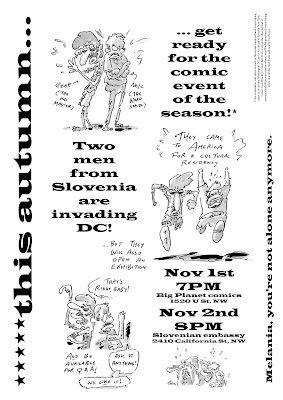 Can you tell us about your history of Slovenian comics presentation?
Can you tell us about your history of Slovenian comics presentation?The day after presenting our book - on November 2nd at 7PM - I'll be opening an exhibition of the best of Slovenian comics at our country's embassy on California street 1210, just a stone's throw from Big Planet Comics on U St, NW. Over 30 oversize prints of pages from our local masters of the medium will be on display and I'll bring a bunch of original books too. Translations will be provided and I'll open the expo with a brief talk on the history of Slovenian comics to give some context. Ours is a small country but the comics medium has produced a handful of truly class A creators that are really worth getting acquainted with, I promise. Again, there might be food and wine, so ...
Do you have a website or blog?
I have this blog but it's in Slovenian. The best way to check out and follow my work right now, I think, is through Instagram, where I regularly post works in progress and finished stuff. My username is giraffedetective. Go figure.
Wednesday, July 11, 2018
John K Snyder III on ‘Eight Million Ways to Die’
 |
| Images from Eight Million Ways to Die courtesy of John K Snyder III and IDW |
Comics creator John K Snyder III spent much of his early career in Northern Virginia and Washington, D.C., but these days lives in western Virginia. He occasionally visits the area for local comics shows and to catch up with friends. John will be in town Saturday, July 14, at Big Planet Comics in Bethesda to sign his new graphic novel Eight Million Ways to Die, an adaptation of the Lawrence Block detective novel.(See info, below.)
Below is a Q&A we did with John about the new book ahead of this weekend’s signing.

What was it about Eight Million Ways to Die — Lawrence Block’s fifth book featuring the gumshoe Matthew Scudder — that you thought would be ideal to adapt into a graphic novel?
I thought Block's study of the human condition told through the detective/mystery genre lent itself to do something other than the typical slam-bang action sometimes associated with pulp fiction comics, though there's certainly enough of it in the story as well. Also, Block's work is very much dialogue-driven, which makes it a natural to adapt to the panel-to-panel format of comics storytelling.
What was your approach to adapting the book? Was Block involved in the process, or did he just hand it off to you? How involved were IDW editors?
I worked solo on the adaptation, and Lawrence was shown pages from time to time by my editor, Tom Waltz. It was always great to get a short note back he was pleased with how it was progressing, that's all I needed to hear to keep moving on. My adaptation process was to keep Block's writing as close to the original as possible, and to focus on the key points of the story to mirror as much of the feel and pace of the original novel. It was a very involved and fluid process, I had to be open to revise and cut sequences all the way through to the end. My gracious editor, Tom Waltz, gave me a free hand to tell the story my way, for that I'll always be grateful. Lawrence Block read and approved of the book once it was completely adapted, illustrated and lettered (by Frank Cvetkovic). Lawrence Block's enthusiastic response to the final product was just wonderful.
The story takes place in the early 1980s, but it’s not stylized in a 1980s kind or way, nor is it overloaded with cultural references that might date it. How did you balance that?
I thought of it in real time, how do we experience our day-to-day lives now? What marks the time period we are in? Our own daily cultural reminders are subtle, in the clothing, the technology, what's in the background. In this graphic novel, it's 1982 New York City—the characters use land line phones, answering services, and phone booths, read newspapers, people look for people by going to their familiar hangouts on the notion they'll be there, not by texting in advance. So the period is defined enough by the characters' actions, how they get around—there's not too much of a need to layer on top of that with additional symbols of the period. I did throw in a concert poster of The Who at Shea Stadium, with opening act, The Clash. That's a cultural moment that was a sign of the changing times, and in fact, The Clash weren't around long after that. It's good to throw in some specific references, but to choose ones that count.
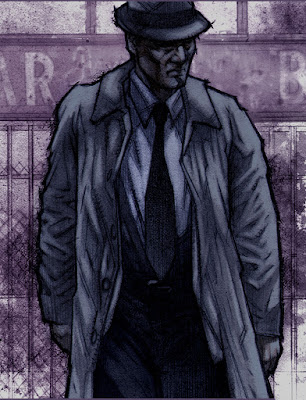
The book has an incredible gritty atmosphere, conveyed through the way you illustrated it. Can you briefly outline your approach? I believe you drew and colored it by hand? How long did the project take, including the writing and illustrating?
I wrote a detailed explanation of my process in a recent article. But for the somewhat shorter version, the pages are all done by hand, fully penciled, sometimes inked, and light to solid color rendering over the pencil/ink, then all adjusted in photoshop, making multiple scans of the pages in different stages and layering them in portions, fusing them all together for the final effect. I guess you could say it's a little like old school animation, laying different animation cels one atop another to create depth. Being the first time adapting Block's work and also developing this illustration process, it took a considerable amount of time to figure it all out, but by the time it got to the last third or so of the book, I had it down to a rhythm of regular production.
Although the story takes place in New York City, did you look back to you time living in D.C. in the ‘80s (which itself was rather gritty at that time) for particular influences?
Absolutely! The book takes place in fall of 1982, at that time, I was living on King St in Old Town Alexandria, pre-Metro Station, and it held its own kind of dystopian vibe, though certainly not on the epic scale of New York City. I would regularly head down to DC Space at 7th and E streets NW and the original 9:30 Club at the Atlantic Building at 930 F Street NW, all of which was just a short drive away from Alexandria. And Old Town had its own little dive club, The Upstairs 704, directly on 704 King St. There was plenty of past inspiration to draw on between all of those locations alone, believe me. And I was quite enamored of New York City, my first time there was in the summer of 1981 — it was a brief visit, but I kept that in mind as well. All in all, it was quite an era. I hope readers will get some of the vibe of that period while reading the adaptation as well.
Friday, November 17, 2017
Book Review: Comic Shop: The Retail Mavericks Who Gave Us a New Geek Culture
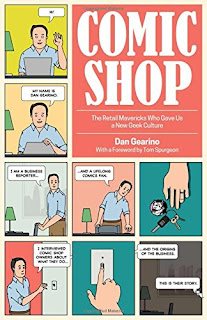
reviewed by Mike Rhode
Comic Shop: The Retail Mavericks Who Gave Us a New Geek Culture
by Dan Gearino, Ohio University Press' Swallow Press, 2017. $26.95
From the 1920s through the 1970s, comic books were sold in newsstands, mom and pop shops and anywhere a distributor could place a rack. Personally, for me, the 7-11 was the main site. The books were dumped on the store which was expected to rack them, and return them for credit when they didn't sell. The comics had a profit for the store in the pennies, so little attention was paid to them. At many times, the books weren't delivered or racked, but a refund was requested anyway, leading to fraudulent losses for the publishers, or misleading sales figures.
In 1973, Phil Seuling, an early creator of Comic Cons, made a deal with DC Comics to buy books for them at a larger discount but on an nonreturnable basis, and get them shipped directly from the printer. Seuling's new company was Sea Gate Distributors. It was soon joined by many competitors who split the United States up between them. As in most businesses, the early wide-open days with multiple distributors and thousands of comic book shops saw financial peaks and troughs as well as widespread consolidations and bankruptcies. Gearino also weaves through the rise of independent comic books such as Elfquest, Bone, Cerebus and the Teenage Mutant Ninja Turtles, and talks about the importance of a retailer hand-selling these types of comics. Today, one distributor remains standing - Baltimore's Diamond Comics, and we're currently seeing a lot of independent books, small publishers and tactics such as variant covers that usually precede a bust in the market.
Gearino did a good job in doing interviews for his research on the book, but is lighter on using archival and printed sources. His focus on Laughing Ogre's small chain occasionally slows the book down, but I think proved to be a good choice to center the story. An odd choice was made to add in profiles of various stores at the end of the book - not quite an appendix, but not quite part of the book either. I think those could have perhaps been integrated in more seamlessly, although when he invites guest commentary in the main text, it is set off at the end of the chapter and is rather jarring. On a local note, Joel Pollack of Big Planet Comics has a two-page profile in the stores section.
This won't be the definitive study of the rise of the Direct Market and specialty comic book stores, but it's a good early step and a fine choice for the casually-interested reader. I enjoyed it and would recommend it.
Monday, October 02, 2017
SPX Oral History - Joel Pollack
 |
| Rhode & Pollack at Baltimore Comic Con 2014 |
Joel Pollack founded Big Planet Comics in Bethesda, MD in 1986, and is still behind the counter a few days a week. The chain has grown to four stores, as Joel's former employees have opened their own stores. Joel was at the beginning of the Small Press Expo and jotted a few notes down.
I was involved in the first ten or so. The first was a collaboration between Jon Cohen (Beyond Comics), Lou Danoff (Zenith Comics), and myself with moral support (and much feedback) of Dave Sim (Cerebus) and Jeff Smith (Bone). It was planned for a Thursday evening before a Diamond Comic Distributor trade show. It was held at the Ramada Inn in Bethesda. Retailers were invited to set up.
What was your role? How did it change over time?
I'd like to think that I was a bit of a moral compass. I believe my greatest contribution to SPX was disallowing retailers from setting up, starting with the second SPX. I felt that it was a show about creators, and that creators shouldn't have to compete with retailers selling their products. As time went on, my role quickly diminished, and ultimately became the one task of procuring the park for the Sunday picnic/softball game. I actually umpired a few of the games.
Where was SPX when you worked on it?
Mostly Bethesda, though I believe I had some small role the one year it moved to Silver Spring.
What were some memorable events?
One of the big ones was Chris Oarr's tenure as executive director. I believe it was Chris who introduced the Sunday picnic/softball game and pig-roast. I believe it was Chris' idea to create the Ignatz Awards. Chris created the template for the current SPX.
What were your favorite parts of SPX?
The feeling of camaraderie amongst exhibitors and staff. The great volunteers that SPX attracted. The opportunity for creators to meet their fans, and sell their creations which were generally unavailable in comic shops.
Tuesday, September 05, 2017
Joel Pollack Remembers Bernie Wrightson (part 2)
by Lee Benaka
Originally published in CFA-APA #101, March 2017 fanzine
Lee Benaka is a Washington, DC, original comic art collector who maintains a searchable database on comic art sales at www.comicartads.com.
 |
|
Frankenstein art for sale from Joel’s Fantastique Illustration #3 catalog, 1984.
|
Joel: Whenever I visited Bernie, we would always have dinner at least one night at a restaurant that was owned by Albert Grossman. He was the manager for Bob Dylan. He owned a restaurant in Woodstock called the Little Bear. It was a Chinese restaurant. We always had dinner there. It was usually a group of us. Usually Jeff Jones came along, with Bernie and Michele, and Jeff’s current girlfriend at the time, whoever it might be.
talking about how horribly Barry treated his girlfriend Linda Lessman. They all kind of looked down on Barry for that, because Linda was a sweet person.
Lee: The first time you went to Bernie’s place, you obviously went with some money in your pocket. Was that a large amount of money that you had saved, or a fairly modest amount?
 |
|
Bernie Wrightson art from Joel’s Fantastique Illustration #1 catalog, 1983.
|
Joel: I brought as much money as I had at any given time. It was probably a modest amount by today’s standards, but it still bought a lot of Wrightson artwork. He was selling it to me very reasonably.
Lee: Did you zero in on certain pages? Did he have Swamp Thing pages?
Joel: I have owned one Swamp Thing page, but I don’t really believe he still had any of that art at that point. Bernie sold a lot of what he did. He didn’t hang on too much, although he still has stuff, I’m pretty sure. I was probably visiting him between 1982 and 1985. I opened a shop in 1986, and I don’t know whether I was visiting him at that point.
Lee: When you got the art from Bernie, did you just list it in the catalog, or did you have contacts you would call to let them know about the art?
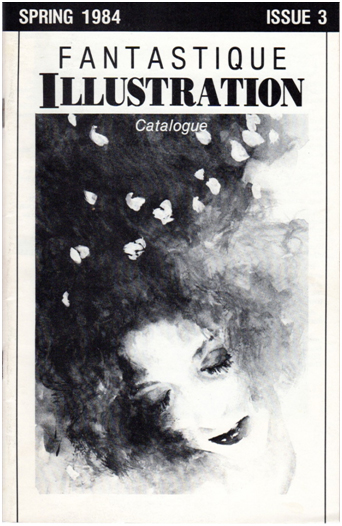 | ||
|
The cover of Joel’s Fantastique Illustration #3 catalog, 1984.
|
Joel: I think I was just selling through the catalogs. I think I probably advertised the catalog in early issues of the Comic Buyer’s Guide. I had a mailing list, but I didn’t necessarily talk to anyone on the telephone. I remember one of the early people on my list was Benno Rothschild. I was a charter member of the CFA-APA, so I had a lot of connections that way.
Bernie really liked dealing with me because I always paid cash. I always brought cash, never a check.
Lee: Did you keep any pieces for yourself?
Joel: For a long time I did. I kept four of five of the very best Frankensteins that I had. I had the title page. But I ran into tax problems sometime in the 1980s, and I
was really dumb. Instead of borrowing money from friends to pay taxes, or taking out a loan to pay taxes, I sold art. I got good money for it. The title page for Frankenstein, I got $2,500 for it. You know what that’s worth now? I wouldn’t be shocked if you could get $100,000 for that right now. Certainly $50,000, just like that, I’m sure.
Lee: Do you remember who you sold those to?
Joel: The title page I might have sold to Richard Kelly, but then when Richard switched over to illustration art, he sold that himself.
Lee: You stopped going to Bernie’s house around the time you opened your shop?
Joel: I think I pretty much did. We had Bernie in for a signing at one point. He had a very aggressive girlfriend who was marketing him. I don’t remember her name. She was very attractive, and she was definitely smart. She wanted to make sure Bernie got paid properly, which he did. We did get to do a Wrightson signing with him. It could have been Hooky, because I had a lot of the Hooky pages at one point. I don’t think I ever had any of the Thing/Hulk pages. But I had a bunch of the Hooky pages. I probably had 20 of those pages at least.
 |
|
An ad that was included as part of Joel’s contribution to CFA-APA #5, 1986.
|
I don’t think I ever got to watch Bernie draw. When we moved him from Queens to Kansas City, though, I remember he threw away a lot of artwork. He lived in a building where Simonson and Chaykin were both living at the time, and Simonson and Chaykin were always raiding his trash can. Bernie would throw away really nice artwork, because it wasn’t perfectly the way he wanted it. You’ve seen all the Frankenstein “outtakes”. There’s probably 50 Frankenstein drawings that never got published. Bernie was a real perfectionist. Sometimes he would lose interest in something, and you would look at it and ask, “Why? This is fantastic.”
After Frankenstein, I think he went through a fallow
period. I think it’s because he spent
himself on Frankenstein. Originally, he
was going to self-publish Frankenstein.
I don’t think he had the patience for business. He didn’t want to have to do all the work
that was involved with self-publishing.
It’s a shame a fan didn’t step forward and say, “I’ll publish for you
Bernie. I’ll take care of all the
details and do it.” He ended up selling
it to Marvel, and I think that took a little bit out of him emotionally. His work seemed to slip a bunch at that
time. He was also having
some allergy problems with his hands.
Evidently the ink and part of his brush were causing his hands to get eczema,
where they were cracking. That might
have affected him a bit too.
But
I think that Frankenstein was such a masterpiece, and he sweated blood into
that. It’s hard to say that he ever did
work that was better than that. He had
moments that were equally as good. But
he went through a period where he did a bunch of comics for Marvel, which he
said he would never do. He didn’t really
want to do comics again, but he went back and did comics, because he had kids
then, and he had to earn a living.
Bernie had a lot of years there where he wasn’t living up to his
promise, and I think he’d be the first one to really tell you that privately,
if not outwardly. Maybe his heart wasn’t
into it. I’ve been told that having kids
can be a huge distraction. I don’t think
you could say that the work he did on Punisher: POV and Batman: The Cult was as
good as the work he did on Swamp Thing, or for Warren magazines. The work he did for Warren was amazing. That was probably his high point in
comics.
It’s
interesting because, the thing he did a few years ago, Frankenstein Alive,
Alive! That was a return to form for
him. I was amazed. He really seemed inspired by that. It’s a real shame that it probably never will
be finished. And if it’s not finished,
they should still publish what’s there in a paperback, because it deserves to
be in permanent form.
I’m
not sure I fully appreciated how talented he was back then, compared to how I
look at him now. Genius might be the
wrong word for him, because all his genius was just in one area—drawing. But he was a prodigy. He was great from day one, and he just kept
getting better.
 |
|
Bernie Wrightson’s preliminary drawing
for the cover of Toe Tags Featuring George Romero #3 (DC Comics, 2005) (from
the collection of Joel Pollack).
|
Subscribe to:
Posts (Atom)








